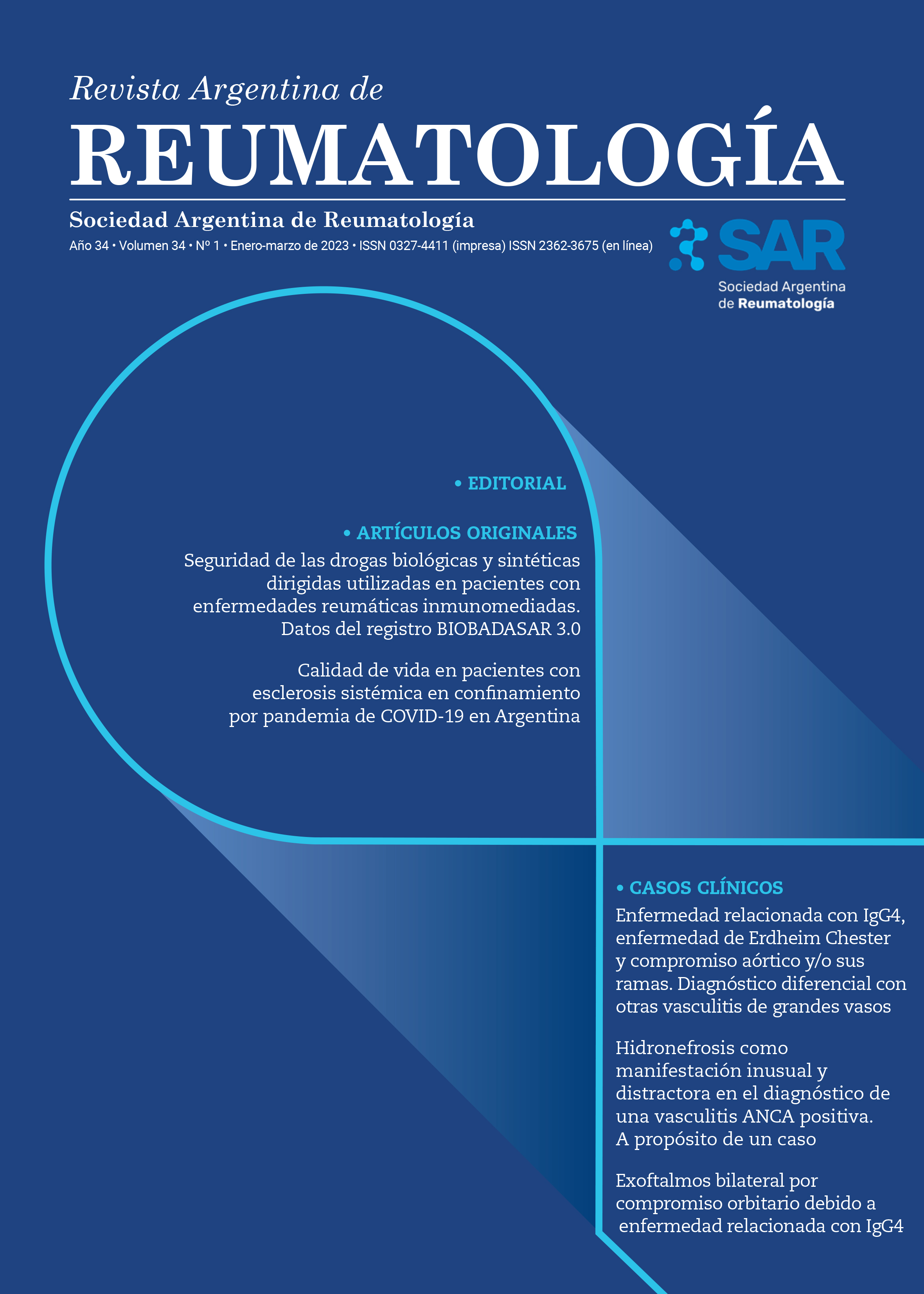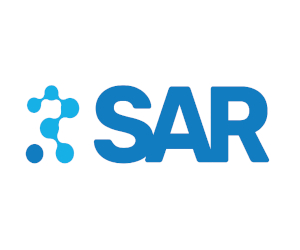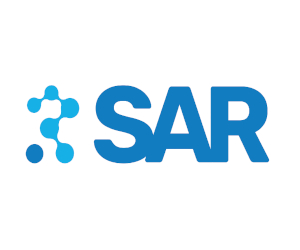Safety of biological and targeted synthetic drugs in patients with immune-mediated rheumatic diseases. Data from the BIOBADASAR 3.0 registry
Abstract
Introduction: knowing the efficacy and safety of the drugs currently available for the treatment of rheumatic diseases is very important when making objective and individualized therapeutic decisions in daily medical consultation. Likewise, real-life data extends the knowledge revealed by clinical trials. Objectives: To describe the reported adverse events (AEs), estimate their frequency and identify factors associated to them Materials and methods: BIOBADASAR data were used, which is a voluntary, prospective follow-up registry of AEs of biological and synthetic treatments in patients with immune-mediated rheumatic diseases. Patients are followed until death, loss of follow-up, or withdrawal of informed consent. To carry out this analysis, the data collected up to January 31, 2023 was extracted. Results: a total of 6253 patients were included, who contributed with 9533 treatment periods, including 3647 (38.3%) periods without b/ts-DMARDs and 5886 (61.7%) with b/ts-DMARDs. Among the latter, the most used were TNF inhibitors and abatacept. A total of 5890 AEs were reported in a total of 2701 treatments (844 and 1857 without and with b/ts-DMARDs, respectively), with an incidence of 53.9 events per 1000 patients/year (95% CI 51.9-55.9). It was higher during the periods with b/ts-DMARDs (71.1 events per 1000 patients/year, 95% CI 70.7-77.5 vs 33.7, 95% CI 31.5-36.1, p<0.001). Infections, particularly those of the upper respiratory tract, were the most frequent AEs in both groups. 10.9% were severe and 1.1% were associated with the death of the patient. 18.7% of the periods with b/ts-DMARDs were discontinued due to an AE, significantly higher than that reported in the other group (11.5%; p<0.001). In the adjusted analysis, b/ts-DMARDs were associated with a higher risk of presenting at least one AE (HR 1.82, 95%CI 1.64-1.96). Similarly, older age, longer evolution time, history of chronic obstructive pulmonary disease, diagnosis of systemic lupus erythematosus, and use of corticosteroids were associated with a higher risk of AE. Conclusions: the incidence of AEs was significantly higher during those treatment periods that included DME-b/sd.References
I. Aletaha D, Maa JF, Chen S, Park SH, Nicholls D, Florentinus S, et al. Effect of disease duration and prior disease-modifying antirheumatic drug use on treatment outcomes in patients with rheumatoid arthritis. Ann Rheum Dis 2019;78(12):1609-1615.
II. Smolen JS, Breedveld FC, Burmester GR, Bykerk V, Dougados M, Emery P, et al. Treating rheumatoid arthritis to target: 2014 update of the recommendations of an international task force. Ann Rheum Dis 2016;75(1):3-15.
III. Smolen JS, Aletaha D, Koeller M, Weisman MH, Emery P. New therapies for treatment of rheumatoid arthritis. Lancet 2007;370(9602):1861-74.
IV. Pincus T, Sokka T. Should contemporary rheumatoid arthritis clinical trials be more like standard patient care and vice versa? Ann Rheum Dis 2004;63 Suppl 2:ii32-ii39.
V. Misra DP, Agarwal V. Real-world evidence in rheumatic diseases: relevance and lessons learnt. Rheumatol Int 2019;39(3):403-416.
VI. Hyrich KL, Zink A. What can rheumatology expect from real-world data? Rheumatology (Oxford) 2020;59(1):12-13.
VII. De la Vega M, da Silveira de Carvalho HM, Ventura-Ríos L, Goycochea-Robles MV, Casado GC. The importance of rheumatology biologic registries in Latin America. Rheumatol Int 2013;33(4):827-35.
VIII. Carmona L, de la Vega M, Ranza R, Casado G, Titton DC, Descalzo MA, et al. BIOBADASER, BIOBADAMERICA, and BIOBADADERM: safety registers sharing commonalities across diseases and countries. Clin Exp Rheumatol 2014;32(5 Suppl 85):S-163-7.
IX. De la Vega M, Casado G, Citera G, Soriano E, Venarotti H, Saurit V, et al. Primer reporte de eventos adversos de tratamientos biológicos en Argentina. Informe de Registro BIOBADASAR. Rev Arg Reumatol 2011;22(4):40-54.
X. Naranjo CA, Busto U, Sellers EM, Sandor P, Ruiz I, Roberts EA, et al. A method for estimating the probability of adverse drug reactions. Clin Pharmacol Ther 1981;30(2):239-45.
XI. Gómez G, Pons-Estel G, Citera G, Soriano E, Saurit V, Benavidez F, et al. Sexto reporte de eventos adversos con tratamientos biológicos en Argentina. Informe del registro BIOBADASAR. Rev Arg Reumatol 2019;30(1):4-9.
XII. Titton DC. BiobadaBrasil: Brazilian biologic registry. Rev Bras Reumatol 2011;51(2):111-2.
XIII. Titton DC, Silveira IG, Louzada-Junior P, Hayata AL, Carvalho HM, Ranza R, et al. Brazilian biologic registry: BiobadaBrasil implementation process and preliminary results. Rev Bras Reumatol 201;51(2):152-60.
XIV. de Abreu P, Ávila-Pedretti G, Morel Z, Acosta MI, Cabrera-Villalba S, Melgarejo P, et al. Safety and survival associated with biologic therapies: first report of the Biobadaguay on the Paraguayan-Uruguayan Registry of Adverse Events with Biologic Therapies. Reumatol Clin (Engl Ed) 2020;16(5 Pt 2):396-404.
XV. Rodríguez-Lozano C. Seguridad de las terapias biológicas: nuevos datos de BIOBADASER. Reumatol Clin 2011;6S3:S1-6.
XVI. Harris J, Keane J. How tumor necrosis factor blockers interfere with tuberculosis immunity. Clin Exp Immunol 2010;161(1):1-9.
XVII. Actualización de las guías de práctica clínica en el tratamiento de la artritis reumatoidea. Capítulo 8: agentes biológicos antifactor de necrosis tumoral alfa. Rev Arg Reumatol 2013;196-7.
XVIII. Carmona L, Gómez-Reino JJ, Rodríguez-Valverde V, Montero D, Pascual-Gómez E, Mola EM, et al. Effectiveness of recommendations to prevent reactivation of latent tuberculosis infection in patients treated with tumor necrosis factor antagonists. Arthritis Rheum 2005;52(6):1766-72.
XIX. Chaer FGG, de Lucena Valim JM, Reis RC, Klautau GB, de Souza BDB. Use of biologic agents and risk of tuberculosis in Brazil, a tuberculosis high-burden country. Drugs Context 2020;9:212598.
XX. Sunzini F, McInnes I, Siebert S. JAK inhibitors and infections risk: focus on herpes zoster. Ther Adv Musculoskelet Dis 2020;12:1759720X20936059.
XXI. Kivitz AJ, Cohen S, Keystone E, van Vollenhoven RF, Haraoui B, Kaine J, et al. A pooled analysis of the safety of tofacitinib as monotherapy or in combination with background conventional synthetic disease-modifying antirheumatic drugs in a Phase 3 rheumatoid arthritis population. Semin Arthritis Rheum 2018;48(3):406-415.
XXII. Frisell T, Bower H, Morin M, Baecklund E, Di Giuseppe D, Delcoigne B, et al. Safety of biological and targeted synthetic disease-modifying antirheumatic drugs for rheumatoid arthritis as used in clinical practice: results from the ARTIS programme. Ann Rheum Dis 2023:ard-2022-223762.
XXIII. Singer D, Thompson-Leduc P, Poston S, Gupta D, Cheng WY, Ma S, Devine F, Duh MS, Curtis JR. Incidence of herpes zoster in patients with rheumatoid arthritis in the United States: a retrospective cohort study. J Rheumatol 2023:jrheum.220986.
XXIV. Curtis JR, Xie F, Yun H, Bernatsky S, Winthrop KL. Real-world comparative risks of herpes virus infections in tofacitinib and biologic-treated patients with rheumatoid arthritis. Ann Rheum Dis 2016;75(10):1843-7.
XXV. Isnardi CA, Roberts K, Saurit V, Petkovic I, Báez RM, Quintana R, et al. Sociodemographic and clinical factors associated with poor COVID-19 outcomes in patients with rheumatic diseases: data from the SAR-COVID Registry. Clin Rheumatol 2023;42(2):563-578.
XXVI. Strangfeld A, Schäfer M, Gianfrancesco MA, et al. Factors associated with COVID-19-related death in people with rheumatic diseases: results from the COVID-19 Global Rheumatology Alliance physician-reported registry. Ann Rheum Dis 2021;80(7):930-942.
XXVII. Castrejon I, Molina Collada J, Pérez-García C, et al. POS1439 Cancer in patients with rheumatic diseases exposed to different biologic and targeted synthetic DMARDs in real-world clinical practice: data from a multicenter register. Ann Rheum Dis 2022;81:1063.
XXVIII. Instituto Nacional de Estadística y Censos de la República Argentina (INDEC). Resultados provisionales del CENSO Argentina 2022. Acceso: 7/3/23. Disponible en: https://censo.gob.ar/wp-content/uploads/2023/02/cnphv2022_resultados_provisionales.pdf.
Copyright (c) 2023 on behalf of the authors. Reproduction rights: Argentine Society of Rheumatology

This work is licensed under a Creative Commons Attribution-NonCommercial-NoDerivatives 4.0 International License.










